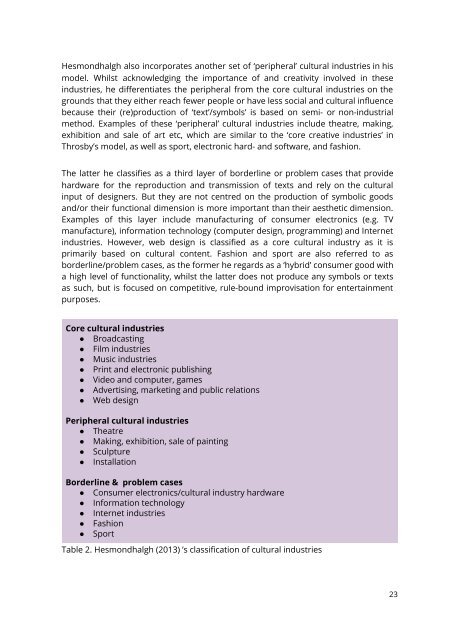MAPPING CULTURE
Mapping-Culture-Venues-and-Infrastructure-in-the-City-of-Sydney
Mapping-Culture-Venues-and-Infrastructure-in-the-City-of-Sydney
You also want an ePaper? Increase the reach of your titles
YUMPU automatically turns print PDFs into web optimized ePapers that Google loves.
Hesmondhalgh also incorporates another set of ‘peripheral’ cultural industries in his<br />
model. Whilst acknowledging the importance of and creativity involved in these<br />
industries, he differentiates the peripheral from the core cultural industries on the<br />
grounds that they either reach fewer people or have less social and cultural influence<br />
because their (re)production of ‘text’/symbols’ is based on semi- or non-industrial<br />
method. Examples of these ‘peripheral’ cultural industries include theatre, making,<br />
exhibition and sale of art etc, which are similar to the ‘core creative industries’ in<br />
Throsby’s model, as well as sport, electronic hard- and software, and fashion.<br />
The latter he classifies as a third layer of borderline or problem cases that provide<br />
hardware for the reproduction and transmission of texts and rely on the cultural<br />
input of designers. But they are not centred on the production of symbolic goods<br />
and/or their functional dimension is more important than their aesthetic dimension.<br />
Examples of this layer include manufacturing of consumer electronics (e.g. TV<br />
manufacture), information technology (computer design, programming) and Internet<br />
industries. However, web design is classified as a core cultural industry as it is<br />
primarily based on cultural content. Fashion and sport are also referred to as<br />
borderline/problem cases, as the former he regards as a ‘hybrid’ consumer good with<br />
a high level of functionality, whilst the latter does not produce any symbols or texts<br />
as such, but is focused on competitive, rule-bound improvisation for entertainment<br />
purposes.<br />
Core cultural industries<br />
● Broadcasting<br />
● Film industries<br />
● Music industries<br />
● Print and electronic publishing<br />
● Video and computer, games<br />
● Advertising, marketing and public relations<br />
● Web design<br />
Peripheral cultural industries<br />
● Theatre<br />
● Making, exhibition, sale of painting<br />
● Sculpture<br />
● Installation<br />
Borderline & problem cases<br />
● Consumer electronics/cultural industry hardware<br />
● Information technology<br />
● Internet industries<br />
● Fashion<br />
● Sport<br />
Table 2. Hesmondhalgh (2013) ’s classification of cultural industries<br />
23



